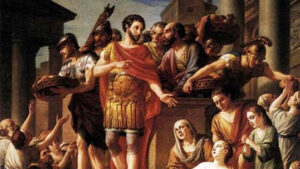Roman Elites Who Acknowledged Reality of Christ

Three Roman society elites – a Roman Senator and Consul; an imperial archive custodian turned Roman historian; a famous comedian – all have one thing in common. Each ridiculed the crucified Jewish Christ and in doing so confirmed his historical existence.
A prominent Roman political figure, Gaius Cornelius Tacitus (56-120 AD), served as a Roman Senator, a Consul, and a provincial governor.[1] Highly esteemed in Roman society was his position as a Senator; moreover, he was voted as a Consul, a dual leader of the Roman Senate.[2]
As a Consul, he was believed to have served as a provincial governor though he gained more fame for his historical work, Annales. In it, he inadvertently made a defense of Christians.
Tacitus called out Nero for falsely blaming the Christians for burning Rome as a means to cover up his own duplicity. Though far from a sympathetic manner, Tacitus was obligated to explain the identity of the Christians:
“Nero fastened the guilt and inflicted the most exquisite tortures on a class hated for their abominations, called Christians by the populace. Christus, from whom the name had its origin, suffered the extreme penalty during the reign of Tiberius at the hands of one of our procurators, Pontius Pilatus, and a most mischievous superstition, thus checked for the moment, again broke out not only in Judaea, the first source of the evil, but even in Rome, where all things hideous and shameful from every part of the world find their centre and become popular.”[3]
Christus is Latin for Christ as well as the Greek word Christos, both meaning “Messiah.”[4] Some skeptics suggest that since the name of Jesus was not actually mentioned, there is no proof Christus refers to Jesus.[5]
Suetonius (circa 71-135 AD), another Roman historian, was a close friend with Roman Consul Pliny the Younger, who was also a lawyer and author. Pliny considered Suetonius as a scholar of the highest integrity.
Friendship with Pliny the Younger opened the door to Suetonius for extraordinary opportunities. Suetonius had full access to all of Rome’s libraries; was custodian of the archives of imperial letters written by previous Emperors; and had the responsibility for all imperial correspondence for Emperor Hadrian.[6]
Known for his historical work, The Lives of the Twelve Caesars, written less than 100 years after the crucifixion, covered reigns of the first twelve Roman Emperors from Julius Caesar to Domitian. Suetonius wrote Claudius Caesar placed blame on “Chrestus” as the source of the Jews causing trouble in Rome:
“Since the Jews constantly made disturbances at the instigation of Chrestus, he expelled them from Rome.”[7]
New Testament Book of Acts 18:2 corroborates the statement in The Life of Claudius. The reference says, “… Claudius had commanded all the Jews to leave Rome.”[8]
Critics do not dispute the slightly different spelling of “Christus.” Instead, the same argument used against Tacitus is used for Suetonius’ reference saying since “Jesus” is not mentioned specifically by name, there is no proof that Chrestus is a historical reference to Jesus of Nazareth.
Suetonius made a similar reference as Tacitus in The Life of Nero defining Christians as a class of men motivated by their new Christian teachings. The same words are used by Suetonius to describe Christian beliefs as a “mischievous superstition.”
“Punishment was inflicted on the Christians, a class of men given to a new and mischievous superstition.”[9]
New Christian beliefs were indeed causing problems for Roman rulers. Among them, the Sanhedrin had filed formal charges with Roman Procurator Festus against the Apostle Paul whereupon Paul was discovered to be a Roman citizen who appealed to Caesar and was then imprisonment in Rome.
Another incident dragged in Rome when an illegal execution was reported to Roman Procurator Albinus. According to Josephus, the provocative stoning deaths of Jesus’ brother, James, and his companions were ordered to be stoned by the Sanhedrin Chief Priest.
On a much lighter note, newsworthy personalities of today – gladly or not – know they are in the national discourse when they become the subject of a Saturday Night Live satirical skit. The humor of SNL is based on satire of real high-profile current events with the assumption that their public TV audience is aware of the subject matter.
Lucian, a Greek satirist (circa 115-200 AD), who authored more than 70 works, is considered to be among the greatest of Roman era satirists. As a celebrity, he toured and presented his shows throughout the regions of Greece, Italy and Gaul (France and surrounding areas).[10]
Among Lucian’s works is The Death of Peregrine, a satire about the factual events of a man, Peregrinus Proteus, who cremated himself at the Greek Olympics in 165 AD. Peregrine, at one point in the satire, encountered some Christians of Palestine:
“It was now that he came across the priests and scribes of the 11 Christians, in Palestine, and picked up their queer creed…. The Christians, you know, worship a man to this day, — the distinguished personage who introduced their novel rites, and was crucified on that account.”
“You see, these misguided creatures start with the general conviction that they are immortal for all time, which explains the contempt of death and voluntary self-devotion which are so common among them; and then it was impressed on them by their original lawgiver that they are all brothers, from the moment that they are converted, and deny the gods of Greece, and worship the crucified sage, and live after his laws.”[11]
Lucian’s satire literally played off the actual Gospel’s message little more than a century later. At the risk of his reputation, Lucian assumed his audiences in the late 100s were aware of the fact that Jesus lived; was a Jewish lawgiver who taught the gift of eternal life; and was crucified for his new teachings.
Strength of the evidence from these three sources of antiquity that Jesus is a real historical figure comes in part from their close proximity in history to Procurator Pilate. None had favorable views of the teachings of the founder of Christianity – Tacitus and Suetonius viewed it as a “mischievous superstition” and Lucian made fun of its “queer creed.”
Are the historical references by Tacitus, Suetonius and Lucian to the historic existence of Jesus of Nazareth fact or baseless?
Updated April 14, 2025.
This work is licensed under a Creative Commons Attribution-NonCommercial-NoDerivatives 4.0 International License.
REFERENCES:
[1] “Tacitus.” Encyclopædia Britannica. 2014. “Gaius Cornelius Tacitus.” UNRV History |The Roman Empire. <http://www.unrv.com/bio/tacitus.php> “Tacitus.” Livius.org. Ed. Jona Lendering. 2019. <https://www.livius.org/sources/content/tacitus> “Tacitus.” Encyclopædia Britannica. 2023.<https://www.britannica.com/biography/Tacitus-Roman-historian>
[2] Livius.org. Ed. Jona Lendering. 2019. <http://www.livius.org/cn-cs/consul/consul.html> Roman Consuls.” UNRV History |The Roman Empire. <http://www.unrv.com/government/consuls.php>
[3] Tacitus, Gaius Cornelius. The Annals. 109 AD. Trans. Alfred John Church and William Jackson Brodribb. Internet Classic Archive. 2009. Book XV. <http://classics.mit.edu/Tacitus/annals.html>
[4] “Christus.” Latin Dictionary. 2008. Latin-Dictionary.org. <http://www.latin-dictionary.net> Strong, James, LL.D., S.T.D. “christos <5547>” (Greek). Lexicon-Concordance Online Bible. <http://lexiconcordance.com>
[5] Murdock, D.M. aka S., Acharya. “Pliny, Tacitus and Suetonius: No Proof of Jesus.” Truth Be Known. 2017. <http://www.truthbeknown.com/suetoniuschresto.htmlrel=”nofollow”>
[6] “Suetonius.” Livius.org. Ed. Jona Lendering. 2019. <http://www.livius.org/su-sz/suetonius/suetonius.html> “Pliny the Younger.” TheFamousPeople. n.d. <https://www.thefamouspeople.com/profiles/pliny-the-younger-6380.php>
[7] Suetonius (C. Suetonius Tranquillus or C. Tranquillus Suetonius). The Lives of the Twelve Caesars. Book VI “Nero.” #16. University of Chicago|Bill Thayer. <http://penelope.uchicago.edu/Thayer/E/Roman/Texts/Suetonius/12Caesars/home.html>
[8] New American Standard Bible translation
[9] Suetonius.The Lives of the Twelve Caesars. Book V “Claudius.”
[10] Pearse, Roger, ed. “Lucian of Samosata : Introduction and Manuscripts.” The Tertullian Project. <http://www.tertullian.org/rpearse/lucian/lucian_intro.htm> “Lucian” and “Peregrinus Proteus.” Encyclopædia Britannica. 2017.<https://www.britannica.com/biography/Lucian>. “The Lucian of Samosata Project.” LucianOfSamosata.info. <http://lucianofsamosata.info/#sthash.lMVtk483.dpbs>
[11] Lucian of Samosata. “The Death of Peregrine.” The Works of Lucian of Samosata. Volume IV. Internet Sacred Text Archive. <http://www.sacred-texts.com/cla/luc/wl4/wAXl420.htm>


